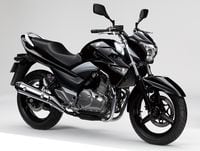Fathers with high-school daughters see young men with trouble in mind coming a mile off, and do their best to aim their offspring in the direction of the nice, not-so-excitable boy. And there he sits, shoes shined, not a speck of food on his Sunday best, nothing but respectful appreciation in his eye. They can take in the late show and you're totally okay with it.
His name is probably Warren, but might as well be GW250.
In today's troupe of entry-level machines, Honda's CBR250R is the lithe athlete, clean cut but a little squirrely. Kawasaki's Ninja 300 hangs out behind the gym and just cut a deal with the nerds to get the shop teacher free wifi in exchange for some after-hours time on the band saw. The little cruisers don't run in this group.
Into the mix walks the GW, physically larger than the others, showing a bit of wardrobe from Uncle B-King, which the other boys view as the plastic-formed equivalent of a mullet. They'd laugh in front of him, but aren't quite sure how strong that 248cc parallel-twin really is.
Needn't have worried. Suzuki's efforts at power production don't aspire to GSX-R levels in the GW. No, the SOHC, two-valve-per-cylinder engine is tuned for tame, making a broad and commendably flat trace across the dyno chart. All hands on smooth delivery and minimal vibration, thanks to a gear-driven counterbalancer and spot-on fueling from a Mikuni single-butterfly (per cylinder) injection system. Suzuki claims 24.1 hp at 8,500 rpm, which is 1.9 hp down from Honda's claim for the one-lung CBR250R. Probably you weren't expecting a trunkload of power from a long-stroke (55.2mm, against a 53.5mm bore), two-valve-per engine. (Indeed, Suzuki goes to some trouble to hide the GW's valve count, including casting the cylinder head to look like a DOHC engine.) Torque is where this kid's at. (Speaking of torque, Suzuki's initial press material listed the torque peak at 2,600 rpm. That was incorrect; the actual torque peak of 16.2 pound-feet occurs at 6500 rpm.)
On the road, the GW keeps its eyes on the textbooks, pencil at the ready. From a steady idle to about 3000 rpm, there's no much happening, but the clutch engages with a liquid smoothness over a reasonably broad flick of the lever. Sufficient flywheel makes it unlikely you'll ever stall it.
Roll it open and the GW chugs up through the range, gaining a little speed by 8000 rpm and finishing with a muted flourish well in advance of the 11,000-rpm redline. A CBR feels stronger right off the bottom but finishes sooner, more frenetically. The Ninja? It'll eat the GW for dinner and make a cage with its bones. Good thing the GW shifts beautifully and shows virtually no driveline lash or other anti-social proclivities. It might not sing loud, but it's always on key. Like a choir boy.
Our experience with the GW came on the streets of Orlando, Florida, so except for a couple of cloverleaf exits and a handful of turns around the convention center, suburban ennui was the best we could do. Here, the GW is great. Light feeling despite tipping the scales at a slightly shameful 403 pounds wet—almost 50 pounds heavier than a CBR—the GW does exactly what you think it will. The commendably low seat height, 30.7 inches, feels even lower thanks to an exaggerated taper to the saddle's forward section.
Good boys don't choose to be that way, they just are. Same for the GW. Every element of its design is biased toward the totally new rider—soft suspension, very relaxed riding position, clear and simple gauges, and a front brake so detuned that it's actually difficult to lock the IRC Road Winner wrapped around the three-spoke cast wheel.
Young riders will feel immediately at ease on the GW, which is precisely how Momma Suzuki raised it to be. It'll do 80-plus on the highway with a little to spare—again, edging the CBR250R but well behind the terrier-like Ninja—should get phenomenal fuel mileage, and costs a buck under four grand. That may well be enough to offset the combed hair and the sweater vest.



















/cloudfront-us-east-1.images.arcpublishing.com/octane/S35YGSEMEZB4BLTDJTSZPF4GLA.jpg)
/cloudfront-us-east-1.images.arcpublishing.com/octane/5UOT6HPX2JFMRJAX6EH45AR4MQ.jpg)
/cloudfront-us-east-1.images.arcpublishing.com/octane/OKWOJWAKP5EP3OACCRRWPCIX2Q.jpg)
/cloudfront-us-east-1.images.arcpublishing.com/octane/2WF3SCE3NFBQXLDNJM7KMXA45E.jpg)
/cloudfront-us-east-1.images.arcpublishing.com/octane/G4MG6OUCJNBSHIS2MVVOTPX65E.jpg)
/cloudfront-us-east-1.images.arcpublishing.com/octane/IIGGWFOTOJGB7DB6DGBXCCMTDY.jpg)
/cloudfront-us-east-1.images.arcpublishing.com/octane/QSTCM6AVEZA5JJBUXNIQ3DSOF4.jpg)
/cloudfront-us-east-1.images.arcpublishing.com/octane/U4I7G625B5DMLF2DVIJDFZVV6M.jpg)
/cloudfront-us-east-1.images.arcpublishing.com/octane/B6XD6LS6IVCQPIU6HXDJSM3FHY.jpg)
/cloudfront-us-east-1.images.arcpublishing.com/octane/ICL63FEDDRDTTMINYICCEYGMDA.jpg)
/cloudfront-us-east-1.images.arcpublishing.com/octane/FCGZHQXRBZFLBAPC5SDIQLVF4I.jpg)
/cloudfront-us-east-1.images.arcpublishing.com/octane/WNOB6LDOIFFHJKPSVIWDYUGOPM.jpg)

/cloudfront-us-east-1.images.arcpublishing.com/octane/X33NU3E525ECRHXLNUJN2FTRKI.jpg)
/cloudfront-us-east-1.images.arcpublishing.com/octane/6KKT5NNL2JAVBOXMZYS5ZO76YA.jpg)
/cloudfront-us-east-1.images.arcpublishing.com/octane/J5RKG5O455GMPGQRF2OG6LRT7A.jpg)
/cloudfront-us-east-1.images.arcpublishing.com/octane/GX2CIZKQVRH2TATDM26KFG2DAE.jpg)
/cloudfront-us-east-1.images.arcpublishing.com/octane/ZWIDYSAKQZHD5BHREMQILXJCGM.jpg)
/cloudfront-us-east-1.images.arcpublishing.com/octane/CYUHJZCTSJCH3MRAQEIKXK7SCQ.jpg)
/cloudfront-us-east-1.images.arcpublishing.com/octane/LKOFINY56FCXJCANJ5M7ZDQUBY.jpg)
/cloudfront-us-east-1.images.arcpublishing.com/octane/4NBPDACMWJH63JQYJVK3QRBDZI.jpg)
/cloudfront-us-east-1.images.arcpublishing.com/octane/KKHQHRR3FJGX7H2IPU6RALMWG4.jpg)

/cloudfront-us-east-1.images.arcpublishing.com/octane/5IOFS5JAE5FOXMNA23ZRAVVYUU.jpg)